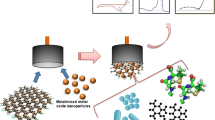Abstract
We show a novel route to prepare SERS substrates, which is based on polymer–metal nanocomposites with a specific structure and composition just below the percolation threshold. The neighboring nanoparticles are still quite densely packed, but remain separated by narrow polymer gaps (<1 nm). Such a nanostructure allows the creation of densely packed hot spots where electromagnetic energy can be confined. The polymer–metal nanocomposites are fabricated by a simple and single-step method of electron-beam-assisted vapor-phase co-deposition. The preparation of the SERS substrates is based on a simple plasma-etching process, which removes the polymer structures that allow the formation of metal nanoparticle SERS nano-aggregates with very uniform and controllable inter-particle gaps. The method results in “ideal SERS hot spots” throughout the matrix. These hot spots can be created over very large areas. The prepared SERS substrates are promising candidates for the direct detection (label-free) and analysis of various biological and chemical samples.
Similar content being viewed by others
References
K. Hering, D. Cialla, K. Ackermann, T. Dörfer, R. Möller, H. Schneidewind, R. Mattheis, W. Fritzsche, P. Rösch, J. Popp, Anal Bioanal Chem. 390, 113 (2008).
R. G. Freeman, K. C. Grabar, K. J. Allison, M. B. Robin, J. A. Davis, A. P. Guthrie, M. B. Hommer, M. A. Jackson, P. C. Smith, D. G. Walter, M. J. Natan, Science 267, 1629 (1995).
Shuming Nie and Steven R. Emory, Science 275, 1102 (1997).
W. E. Doering, M. E. Piotti, M. J. Natan, R. G. Freeman, Adv. Mater. 19, 3100 (2007).
M. A. De Jesus, K. S. Giesfeldt, J. M. Oran, N. A. Abu-Hatab, N. V. Lavrik, M. J. Sepaniak, Appl. Spectrosc. 59, 1501 (2005).
A. Biswas et. al. Nanotechnology 20, 325705 (2009).
A. Biswas, H. Eilers, F. Hidden, O. C. Aktas, and C. V. S. Kiran, Appl. Phys. Lett. 88, 013103 (2006).
S. A. Maier, Optics Express, 14, 1957 (2006).
George C. Schatz, Matthew A. Young, and Richard P. Van Duyne, Electromagnetic Mechanism of SERS, K. Kneipp, M. Moskovits, H. Kneipp (Eds.): Surface-Enhanced Raman Scattering – Physics and Applications, Topics Appl. Phys. (Springer-Verlag, 2006) 19, pp. 103.
V. M. Shalaev, Optical Properties of Nanostructured Random Media, Top. Appl. Phys. V. M. Shalaev (Ed.), (Springer, 2002), 82, pp. 93–114.
Author information
Authors and Affiliations
Rights and permissions
About this article
Cite this article
Biswas, A., Bayer, I.S. & Biris, A.S. Nanocomposite Route to Ultra-sensitive Surface Enhanced Raman Scattering Substrates. MRS Online Proceedings Library 1253, 1027 (2010). https://doi.org/10.1557/PROC-1253-K10-27
Received:
Accepted:
Published:
DOI: https://doi.org/10.1557/PROC-1253-K10-27




